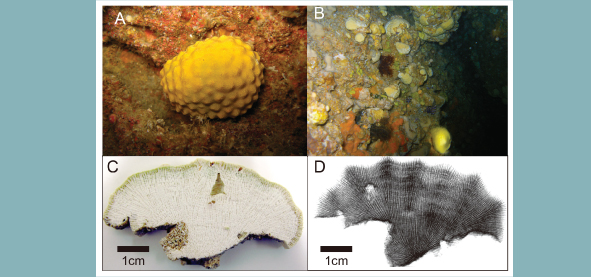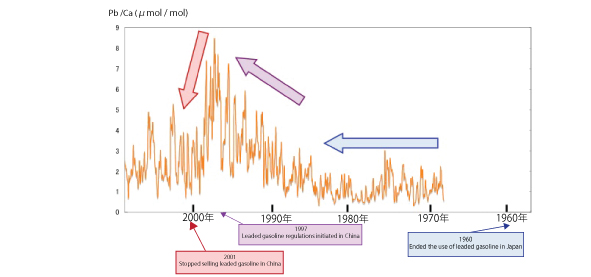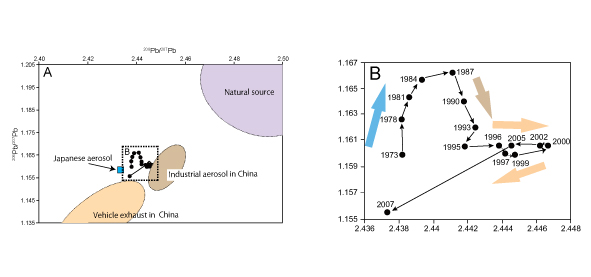Skeletons of Sclerosponges reveal the history of atmospheric lead pollution from mainland China
Research Press Release | April 17, 2014
-
 Sclerosponges were collected at a depth of 20m in Kumejima, Okinawa. A) A living example shows a yellow to orange color with a hard skeleton on the inside. B) The colony chooses its habitat in the narrow caverns at the depths of the ocean floor. C) Cross-section of the skeleton. D) X-ray image shows tubular tissue gathered on the skeleton.
Sclerosponges were collected at a depth of 20m in Kumejima, Okinawa. A) A living example shows a yellow to orange color with a hard skeleton on the inside. B) The colony chooses its habitat in the narrow caverns at the depths of the ocean floor. C) Cross-section of the skeleton. D) X-ray image shows tubular tissue gathered on the skeleton. -
 By studying the lead concentration in the skeletons of sclerosponges, we identified a significant change in concentration over a time span of 40 years.
By studying the lead concentration in the skeletons of sclerosponges, we identified a significant change in concentration over a time span of 40 years. -
 We also measured the isotopic composition, and identified that the source of pollution shifted from Japan to China during this period.
We also measured the isotopic composition, and identified that the source of pollution shifted from Japan to China during this period.
| Press Release | ||
|---|---|---|
| Key Points | ・Sclerosponges, or living fossils, have been discovered at a water depth of 20m in Kumejima, Okinawa.
・Lead concentration contained in the skeletons of sclerosponges explosively increased between 1970 and 2000. ・A shift in the source of lead pollution in the East China Sea shelf from Japan to China was confirmed from the isotopic composition of lead in their skeletons. ・The increase in environmental lead pollution and its development in the East China Sea over the past 40 years was identified. |
|
| Overview | In recent years, trans-border aerosols originating in China, represented by PM2.5—particles less than 2.5 micrometers in diameter—have caused severe environmental pollution around Japan. Aerosole pollution is recorded in the skeletons of sclerosponges which have a maximum lifespan exceeding 1,000 years. These “living fossils” were discovered in Kumejima, Okinawa by a graduate school student from HU, and reveal the history of lead pollution as well as give new insight toward the origins of this pollution. This achievement is an important breakthrough in understanding the effects of social activities on the environment in detail over a long period of time. | |
| Inquiries |
Tsuyoshi Watanabe, Faculty of Science, Hokkaido University TEL & FAX: +81-11-706-4637 E-mail:nabe@mail.sci.hokudai.ac.jp |
|
|
Japanese Link |
生きる化石『硬骨海綿』の骨格に中国大陸からの大気中鉛汚染史を発見 | |
| Publications | Geology (2014.2.25) | |
